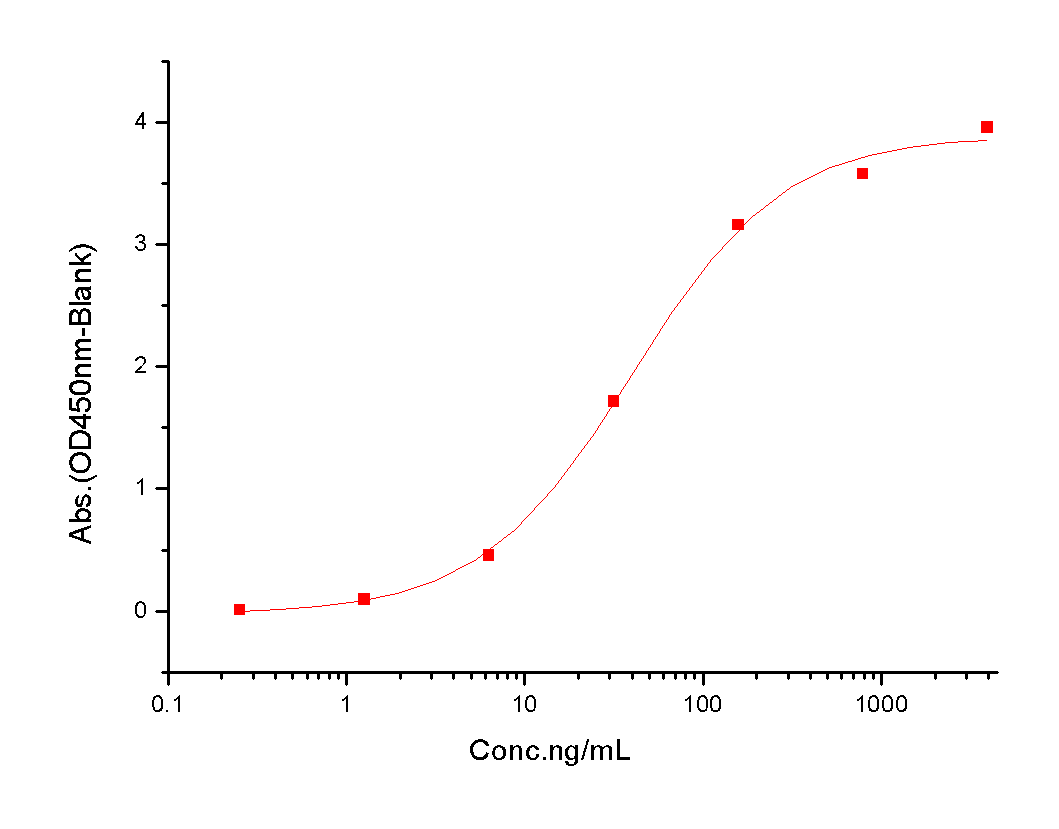Shopping Cart
Remove All Your shopping cart is currently empty
Your shopping cart is currently empty
CD30L Protein, Human, Recombinant (hFc) is expressed in HEK293 mammalian cells with hFc tag. The predicted molecular weight is 47.8 kDa and the accession number is P32971.

| Pack Size | Price | USA Warehouse | Global Warehouse | Quantity |
|---|---|---|---|---|
| 5 μg | $36 | 7-10 days | 7-10 days | |
| 10 μg | $55 | 7-10 days | 7-10 days | |
| 20 μg | $86 | 7-10 days | 7-10 days | |
| 50 μg | $163 | 7-10 days | 7-10 days | |
| 100 μg | $269 | 7-10 days | 7-10 days | |
| 200 μg | $451 | - | In Stock |
| Biological Activity | Measured by its binding ability in a functional ELISA. Immobilized human CD30L-hFc at 2 μg/ml (100 μl/well) can bind human CD30/TNFRSF8-Fch , the EC50 of human CD30/TNFRSF8-Fch is 15-60 ng/mL.  |
| Description | CD30L Protein, Human, Recombinant (hFc) is expressed in HEK293 mammalian cells with hFc tag. The predicted molecular weight is 47.8 kDa and the accession number is P32971. |
| Species | Human |
| Expression System | HEK293 Cells |
| Tag | N-hFc |
| Accession Number | P32971 |
| Synonyms | tumor necrosis factor (ligand) superfamily, member 8,CD30LG,CD30L,CD153 |
| Construction | A DNA sequence encoding the extracellular domain (Gln 63-Asp 234) of human CD30 Ligand (NP_001235.1) was fused with the Fc region of human IgG1 at the N-terminus. Predicted N terminal: Arg 23 |
| Protein Purity | > 95 % as determined by SDS-PAGE  |
| Molecular Weight | 47.8 kDa (predicted); 60-65 kDa (reducing condition, due to glycosylation) |
| Endotoxin | < 1.0 EU/μg of the protein as determined by the LAL method. |
| Formulation | Lyophilized from a solution filtered through a 0.22 μm filter, containing PBS, pH 7.4. Typically, a mixture containing 5% to 8% trehalose, mannitol, and 0.01% Tween 80 is incorporated as a protective agent before lyophilization. |
| Reconstitution | A Certificate of Analysis (CoA) containing reconstitution instructions is included with the products. Please refer to the CoA for detailed information. |
| Stability & Storage | It is recommended to store recombinant proteins at -20°C to -80°C for future use. Lyophilized powders can be stably stored for over 12 months, while liquid products can be stored for 6-12 months at -80°C. For reconstituted protein solutions, the solution can be stored at -20°C to -80°C for at least 3 months. Please avoid multiple freeze-thaw cycles and store products in aliquots. |
| Shipping | In general, Lyophilized powders are shipping with blue ice. |
| Research Background | CD30 ligand (CD30L), also known as CD153 and TNFSF8, is a membrane-associated glycoprotein belonging to the TNF superfamily and TNFR superfamily, and is a specific ligand for CD30/TNFRSF8 originally described as a cell surface antigen and a marker for Hodgkin lymphoma and related hematologic malignancies. CD30L is a type-II membrane glycoprotein expressed on activated T cells, stimulated monocyte-macrophages, granulocytes, eosinophils, and some Burkitt-like lymphoma cell lines. CD30L is capable of transducing signals through CD30 on different CD30+ lymphoma cell lines, and mediates pleiotropic biologic effects including cell proliferation, activation, differentiation, as well as cell death by apoptosis. CD30-CD30 ligand interaction has been suggested to have a pathophysiologic role in malignant lymphomas, particularly Hodgkin disease, large cell anaplastic lymphomas and Burkitt lymphomas, and is also involved in activation and functioning of the T cell-dependent immune response. Thus, CD153 and its receptor CD30 are regarded as therapeutic targets in hematologic malignancies, autoimmune and inflammatory diseases. |
| Size | Quantity | Unit Price | Amount | Operation |
|---|

Copyright © 2015-2026 TargetMol Chemicals Inc. All Rights Reserved.